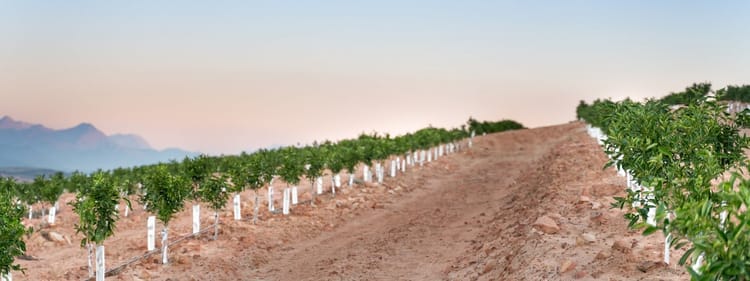Understanding the features that determine dripper success
When technical dripper data is shared, we are confronted by terms that describe certain engineering features, namely K (A); X (B); KD; K (Turbulence coefficient) and Filtration area. These features determine how well a dripper does its job. Understanding them enables us to compare how different drippers do the same job.
Remember the following to navigate technical data:
K (A): Flow rate constant
This is a number specific to each dripper and will be used in flow rate calculations.
X (B): Pressure exponent - The lower the better
A lower pressure exponent will eventually translate to less flow variation along the dripline. This will allow you to use smaller pipes at lower costs and will ensure more uniform water delivery.
KD: Head Loss
This value describes the extent to which the dripper impedes the flow and increases pressure loss in the dripline. It is influenced by dripper size and pipe diameter. The KD of a dripper can be considered neither a disadvantage nor disadvantage.
K: Turbulence coefficient - The higher the better
A higher turbulence coefficient (K) translates to a more turbulent flow path in the dripper. This in turn translates to lower clogging risk. The dripper will be better at keeping itself clean. This value depends on labyrinth depth, width, length (number of teeth), as well as design and manufacturing excellence.
Depth and width of the labyrinth: The wider and deeper, the better
Length of the labyrinth: The shorter, the better
Filtration area: The bigger the better
The larger the area of a dripper’s filter, the more area is available for contaminants to accumulate on and the longer it will take for contaminants to completely cover the filtration area. Therefore, the dripper with the larger filtration area will last longer.
Let's learn more about the turbulence coeficient and its impact.
According to Jerry Austen, product manager at Netafim South Africa, a good quality dripper is one that emits a predetermined flow rate that is accurate and constant over its intended lifespan. To achieve this goal of efficiency, a dripper must be kept clean. A dripper’s ability to stay clean is determined by the turbulence coefficient and the effective filtration area.
Remember, a dripper needs to reduce its inlet pressure from 1 bar to 0 bar and get 1 ℓ/h through it. A complicated mathematical equation explains the pressure difference from the inlet of the dripper flow path to the outlet. All we however need to understand is that the pressure difference comprises two aspects:
- Turbulence
- Friction loss
Pressure loss = turbulence + friction loss
It is important to understand the interaction between these two aspects. Jerry explains that, the less turbulence the dripper can create, the more it has to resort to friction loss to create the necessary pressure loss. The more turbulence (the greater the value of K), the better the dripper is at keeping clean.
Consider the following facts:
- The greater the depth and the width of a dripper labyrinth, the better. A wider and deeper labyrinth results in a higher K value.
- The shorter the length of the dripper labyrinth, the better. The addition of teeth to dripper labyrinths create turbulence, resulting in a turbulent, rather than laminar, flow. This keeps particles in suspension, allowing them to pass through the dripper. A shorter labyrinth has less teeth, resulting in a higher turbulence coefficient (K). The less teeth we have to use to create the necessary friction loss, the better.
Click here to peruse our dripper catalogue to see the K values of each of our drippers.
There is one more secret factor that makes the difference between a good quality and poor-quality dripper, if all technical aspects, such as labyrinth width, depth and length and number of teeth, are equal.
This is the design and manufacturing of the dripper. If the design and manufacture of a dripper labyrinth is not optimal, the turbulence coefficient (K) will be lower and the dripper will need to resort to friction loss to achieve the required pressure loss.
If the teeth of a labyrinth do not have razor sharp edges, more teeth must be added to the labyrinth to create more friction loss. This will not only lower the turbulence coefficient further, but may possibly also mean that the filtration area must be smaller.
Netafim drippers have:
- Razor sharp labyrinth teeth
- Fewer teeth in the labyrinth
- Shorter labyrinths
- High turbulence
- Large filtration area
Click here to watch a video on the technology inside a Netafim dripper.
What is in it for you?
A farmer depends on a dripper’s ability to a supply of water that never varies. This ability depends on the dripper’s ability to keep clean. This depends on turbulence.
An irrigation company knows that it needs to use products that will offer peace of mind in the irrigation system it installs. A clean dripper requires less maintenance, which saves money and labour and offers peace of mind.


Share your thoughts
Comments
We'd love to hear your thoughts! To enter a comment, type your name and email address.